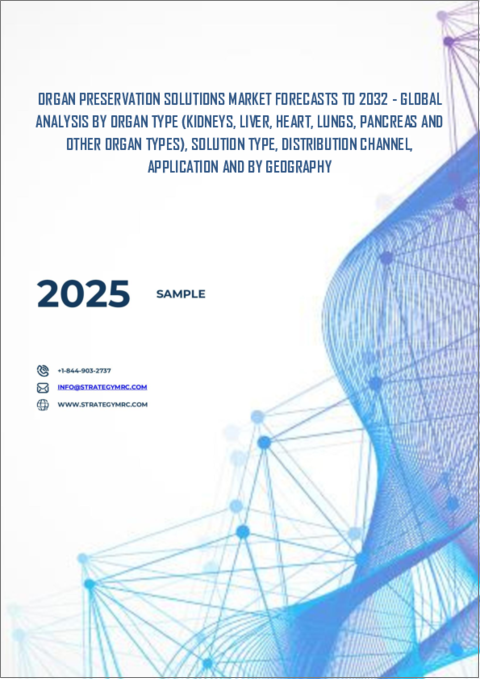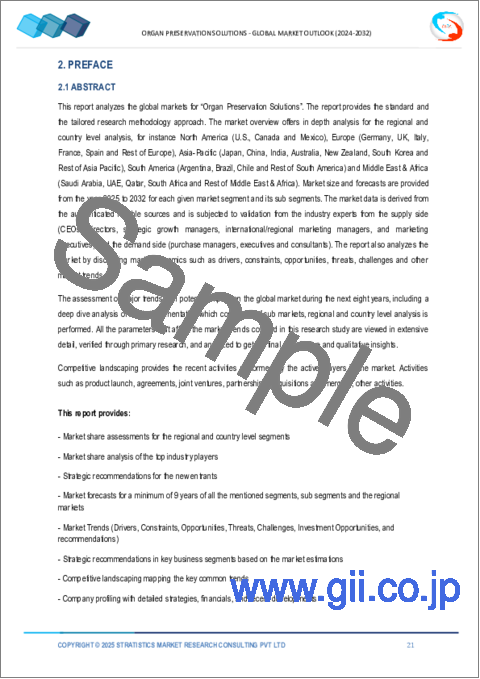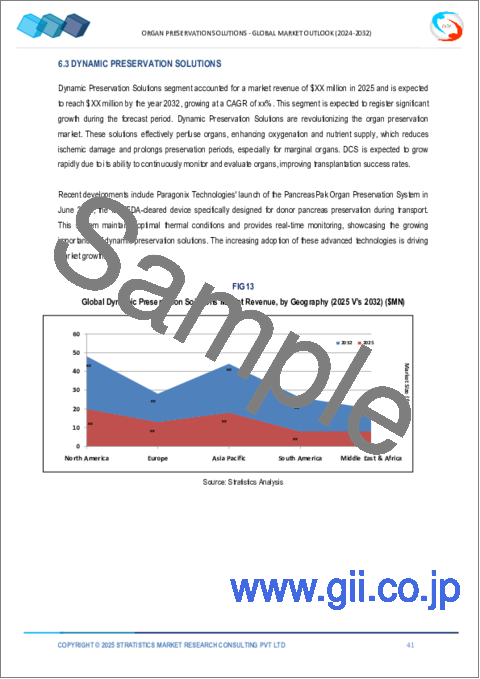|
|
市場調査レポート
商品コード
1636685
臓器保存ソリューション市場の2030年までの予測:臓器タイプ別、ソリューションタイプ別、流通チャネル別、アプリケーション別、地域別の世界分析Organ Preservation Solutions Market Forecasts to 2030 - Global Analysis By Organ Type (Kidneys, Liver, Heart, Lungs, Pancreas and Other Organ Types), Solution Type, Distribution Channel, Application and By Geography |
||||||
カスタマイズ可能
|
|||||||
| 臓器保存ソリューション市場の2030年までの予測:臓器タイプ別、ソリューションタイプ別、流通チャネル別、アプリケーション別、地域別の世界分析 |
|
出版日: 2025年01月01日
発行: Stratistics Market Research Consulting
ページ情報: 英文 200+ Pages
納期: 2~3営業日
|
- 全表示
- 概要
- 図表
- 目次
Stratistics MRCによると、臓器保存ソリューションの世界市場は2024年に2億7,300万米ドルを占め、予測期間中のCAGRは7.5%で成長し、2030年には4億2,130万米ドルに達すると予測されています。
臓器保存ソリューションは、ドナーから臓器を取り出してレシピエントに移植するまでの間、臓器の生存性と機能を維持するために設計された特殊な液体です。これらの溶液は、細胞損傷を防ぎ、代謝活性を低下させ、虚血損傷から組織を保護し、臓器が移植に適した状態を維持できるようにします。通常、臓器を冷却し、臓器の劣化につながる生化学的プロセスを防止することによって、臓器の構造と機能を長期間維持する上で極めて重要です。
米国国勢調査局によると、2024年までに米国人口の20%が65歳以上になると予測されており、臓器移植を必要とする加齢性疾患の発生率が高くなります。
臓器不全の発生率の増加
高齢化、慢性疾患、生活習慣に関連した健康問題などの要因による臓器不全の発生率の増加が、臓器移植の需要を大幅に押し上げています。このことが、臓器保存ソリューション市場の成長に拍車をかけています。移植にはより多くの臓器が必要とされるため、臓器の生存可能性を長期間維持することの重要性が、臓器保存技術やソリューションの進歩につながり、市場の拡大に寄与しています。
臓器の入手可能性が限られている
市場における臓器の入手可能性が限られていることは、臓器移植の待機時間の増加や、臓器移植を必要とする患者のリスクの増大など、重大な課題となっています。この不足は、臓器の生存率と移植成功率を低下させる可能性のある、最適とは言えない保存方法への依存につながります。さらに、需要が供給をはるかに上回るため、ヘルスケアシステムは基準に基づいて患者を優先せざるを得なくなり、しばしば弱い立場に置かれることになります。
高齢人口の増加
高齢人口の増加は、臓器保存ソリューションの需要を大きく促進しています。高齢者は臓器関連の健康問題を抱えやすく、臓器移植を必要とするため、効果的な臓器保存法のニーズが急増しています。この人口動態の変化は、臓器保存技術の進歩に拍車をかけ、臓器移植のためのより長い生存期間とより良い結果を保証しています。加齢関連疾患の発生率の増加と移植ソリューションの必要性が、この市場の主な成長要因です。
処置費用の高さ
同市場における処置にかかる高額な費用は、特に低資源環境において、アクセシビリティとアフォーダビリティに大きな障壁をもたらす可能性があります。こうした費用は、高度な保存技術の利用を制限し、臓器のタイムリーな輸送と移植を妨げる可能性があります。その結果、臓器移植の成功率が低下し、臓器提供システムの全体的な効率が損なわれて、待ち時間の長期化や死亡率の上昇につながる可能性があります。
COVID-19の影響:
COVID-19の大流行は、健康や安全への懸念から、選択的手術を遅らせたり、臓器提供を減らしたりすることで、市場を大きく混乱させました。病院はリソース不足に直面し、臓器の輸送は封鎖や渡航制限によって妨げられました。こうした課題は移植の滞りにつながり、患者の転帰に影響を及ぼし、保存ソリューションに対する全体的な需要を減少させました。さらに、パンデミックはこれらの重要な医療製品のサプライチェーンを緊張させました。
予測期間中、臓器移植分野が最大となる見込み
予測期間中、臓器移植分野が最大の市場シェアを占めると予測されています。効果的な臓器保存は、輸送中の臓器の生存率を維持し、移植を成功させるために不可欠です。臓器提供者の増加に伴い、特に腎臓、肝臓、心臓のような需要の高い臓器では、革新的な保存ソリューションの必要性が高まっています。市場の成長は、移植の成功率と臓器の寿命を高める保存方法の進歩と密接に結びついています。
予測期間中、生体保存分野のCAGRが最も高くなると予想される
生体保存分野は、予測期間中のCAGRが最も高いと予想されます。このアプローチには凍結保存または低体温保存技術が含まれ、凍結や低温による損傷から臓器を保護します。生体保存は、臓器の保存期間を延ばし、虚血性障害を軽減し、移植成功率を向上させることにより、臓器移植におけるより良い結果を保証します。その採用拡大が、臓器保存技術の革新と市場成長の原動力となっています。
最大のシェアを占める地域
予測期間中、北米地域が最大の市場シェアを占めると予測されています。同地域は、低体温法および常温法を含む保存技術の研究開発が盛んです。政府の取り組みや臓器移植への資金援助が、市場の成長をさらに後押ししています。効率的な保存ソリューションに対する北米の高い需要は、移植成功率の向上と臓器拒絶反応の低減の必要性によってもたらされています。
CAGRが最も高い地域:
アジア太平洋地域は、臓器移植の需要が増加しているため、予測期間中に最も高い成長率を記録すると予想されます。臓器移植の需要は、臓器不全や糖尿病や心臓病などの慢性疾患の有病率の上昇により増加しています。さらに、機械灌流や低温保存ソリューションなどの高度な保存方法の開発により、輸送や保存中の臓器の生存率が向上しています。
無料のカスタマイズサービス
本レポートをご購読のお客様には、以下の無料カスタマイズオプションのいずれかをご利用いただけます:
- 企業プロファイル
- 追加市場プレーヤーの包括的プロファイリング(3社まで)
- 主要企業のSWOT分析(3社まで)
- 地域セグメンテーション
- 顧客の関心に応じた主要国の市場推計・予測・CAGR(注:フィージビリティチェックによる)
- 競合ベンチマーキング
- 製品ポートフォリオ、地理的プレゼンス、戦略的提携に基づく主要企業のベンチマーキング
目次
第1章 エグゼクティブサマリー
第2章 序文
- 概要
- ステークホルダー
- 調査範囲
- 調査手法
- データマイニング
- データ分析
- データ検証
- 調査アプローチ
- 調査情報源
- 1次調査情報源
- 2次調査情報源
- 前提条件
第3章 市場動向分析
- 促進要因
- 抑制要因
- 機会
- 脅威
- 用途分析
- 新興市場
- COVID-19の影響
第4章 ポーターのファイブフォース分析
- 供給企業の交渉力
- 買い手の交渉力
- 代替品の脅威
- 新規参入業者の脅威
- 競争企業間の敵対関係
第5章 世界の臓器保存ソリューション市場:臓器タイプ別
- 腎臓
- 肝臓
- 心臓
- 肺
- 膵臓
- その他の臓器タイプ
第6章 世界の臓器保存ソリューション市場:ソリューションタイプ別
- 静電気防止ソリューション
- ウィスコンシン大学(UW)ソリューション
- コリンズソリューション
- セルシオソリューション
- カストジオールソリューション
- ダイナミック保存ソリューション
- 常温機械灌流(NMP)
- 低体温機械灌流(HMP)
第7章 世界の臓器保存ソリューション市場:流通チャネル別
- 直接販売
- 販売業者/卸売業者
- オンライン販売とeコマース
第8章 世界の臓器保存ソリューション市場:アプリケーション別
- 臓器移植
- 医療研究開発
- 医薬品試験
- バイオ保存
- 臨床および診断
- 臓器の回収と輸送
- その他のアプリケーション
第9章 世界の臓器保存ソリューション市場:地域別
- 北米
- 米国
- カナダ
- メキシコ
- 欧州
- ドイツ
- 英国
- イタリア
- フランス
- スペイン
- その他欧州
- アジア太平洋
- 日本
- 中国
- インド
- オーストラリア
- ニュージーランド
- 韓国
- その他アジア太平洋地域
- 南米
- アルゼンチン
- ブラジル
- チリ
- その他南米
- 中東・アフリカ
- サウジアラビア
- アラブ首長国連邦
- カタール
- 南アフリカ
- その他中東とアフリカ
第10章 主な発展
- 契約、パートナーシップ、コラボレーション、合弁事業
- 買収と合併
- 新製品発売
- 事業拡大
- その他の主要戦略
第11章 企業プロファイリング
- Thermo Fisher Scientific
- Merck
- Fisher Scientific
- TSE Systems
- Sorin Group
- Eurobio Scientific
- Baxter International
- Medtronic
- Teva Pharmaceuticals
- Asahi Kasei Medical
- Hemonetics
- Organ Recovery Systems
- TransMedics
- Perfusion Solutions
- Stemcell Technologies
List of Tables
- Table 1 Global Organ Preservation Solutions Market Outlook, By Region (2022-2030) ($MN)
- Table 2 Global Organ Preservation Solutions Market Outlook, By Organ Type (2022-2030) ($MN)
- Table 3 Global Organ Preservation Solutions Market Outlook, By Kidneys (2022-2030) ($MN)
- Table 4 Global Organ Preservation Solutions Market Outlook, By Liver (2022-2030) ($MN)
- Table 5 Global Organ Preservation Solutions Market Outlook, By Heart (2022-2030) ($MN)
- Table 6 Global Organ Preservation Solutions Market Outlook, By Lungs (2022-2030) ($MN)
- Table 7 Global Organ Preservation Solutions Market Outlook, By Pancreas (2022-2030) ($MN)
- Table 8 Global Organ Preservation Solutions Market Outlook, By Other Organ Types (2022-2030) ($MN)
- Table 9 Global Organ Preservation Solutions Market Outlook, By Solution Type (2022-2030) ($MN)
- Table 10 Global Organ Preservation Solutions Market Outlook, By Static Preservation Solutions (2022-2030) ($MN)
- Table 11 Global Organ Preservation Solutions Market Outlook, By University of Wisconsin (UW) solution (2022-2030) ($MN)
- Table 12 Global Organ Preservation Solutions Market Outlook, By Collins solution (2022-2030) ($MN)
- Table 13 Global Organ Preservation Solutions Market Outlook, By Celsior solution (2022-2030) ($MN)
- Table 14 Global Organ Preservation Solutions Market Outlook, By Custodiol solution (2022-2030) ($MN)
- Table 15 Global Organ Preservation Solutions Market Outlook, By Dynamic Preservation Solutions (2022-2030) ($MN)
- Table 16 Global Organ Preservation Solutions Market Outlook, By Normothermic machine perfusion (NMP) (2022-2030) ($MN)
- Table 17 Global Organ Preservation Solutions Market Outlook, By Hypothermic machine perfusion (HMP) (2022-2030) ($MN)
- Table 18 Global Organ Preservation Solutions Market Outlook, By Distribution Channel (2022-2030) ($MN)
- Table 19 Global Organ Preservation Solutions Market Outlook, By Direct Sales (2022-2030) ($MN)
- Table 20 Global Organ Preservation Solutions Market Outlook, By Distributors/Wholesalers (2022-2030) ($MN)
- Table 21 Global Organ Preservation Solutions Market Outlook, By Online Sales & E-Commerce (2022-2030) ($MN)
- Table 22 Global Organ Preservation Solutions Market Outlook, By Application (2022-2030) ($MN)
- Table 23 Global Organ Preservation Solutions Market Outlook, By Organ Transplantation (2022-2030) ($MN)
- Table 24 Global Organ Preservation Solutions Market Outlook, By Medical Research & Development (2022-2030) ($MN)
- Table 25 Global Organ Preservation Solutions Market Outlook, By Pharmaceutical Testing (2022-2030) ($MN)
- Table 26 Global Organ Preservation Solutions Market Outlook, By Biopreservation (2022-2030) ($MN)
- Table 27 Global Organ Preservation Solutions Market Outlook, By Clinical and Diagnostic (2022-2030) ($MN)
- Table 28 Global Organ Preservation Solutions Market Outlook, By Organ Recovery & Transportation (2022-2030) ($MN)
- Table 29 Global Organ Preservation Solutions Market Outlook, By Other Applications (2022-2030) ($MN)
Note: Tables for North America, Europe, APAC, South America, and Middle East & Africa Regions are also represented in the same manner as above.
According to Stratistics MRC, the Global Organ Preservation Solutions Market is accounted for $273.0 million in 2024 and is expected to reach $421.3 million by 2030 growing at a CAGR of 7.5% during the forecast period. Organ preservation solutions are specialized fluids designed to maintain the viability and function of organs during the period between their removal from a donor and transplantation into a recipient. These solutions help prevent cellular damage, reduce metabolic activity, and protect tissues from ischemic injury, ensuring that the organ remains suitable for transplantation. They are critical in preserving the organ's structure and function for extended periods, typically by cooling the organ and preventing biochemical processes that could lead to organ deterioration.
According to the U.S. Census Bureau, it is projected that 20% of the U.S. population will be aged 65 and older by 2024, leading to a higher incidence of age-related diseases necessitating organ transplants.
Market Dynamics:
Driver:
Increasing incidence of organ failure
The increasing incidence of organ failure, driven by factors such as aging populations, chronic diseases, and lifestyle-related health issues, has significantly boosted the demand for organ transplantation. This, in turn, has fueled the growth of the organ preservation solutions market. As more organs are needed for transplantation, the importance of preserving organ viability for longer durations has led to advancements in preservation technologies and solutions, contributing to market expansion.
Restraint:
Limited availability of organs
The limited availability of organs in the market poses significant challenges, including increased organ transplant waiting times and heightened risks for patients in need. This scarcity leads to a reliance on suboptimal preservation methods, which may reduce organ viability and transplant success rates. Additionally, the shortage contributes to ethical concerns, as demand far exceeds supply, forcing healthcare systems to prioritize patients based on criteria, often leaving vulnerable groups at a disadvantage.
Opportunity:
Growing geriatric population
The growing geriatric population is significantly driving the demand for organ preservation solutions. As the elderly are more prone to organ-related health issues and require organ transplants, the need for effective preservation methods has surged. This demographic shift is spurring advancements in organ preservation technologies, ensuring longer viability and better outcomes for organ transplants. The increasing incidence of age-related diseases and the need for transplantation solutions are key growth factors in this market.
Threat:
High cost of procedures
The high cost of procedures in the market can create significant barriers to accessibility and affordability, particularly in low-resource settings. These expenses may limit the availability of advanced preservation technologies, hindering the timely transport and transplantation of organs. As a result, the success rates of organ transplants could decline, and the overall efficiency of organ donation systems may be compromised, leading to prolonged waiting times and increased mortality rates.
Covid-19 Impact:
The COVID-19 pandemic significantly disrupted the market by delaying elective surgeries and reducing organ donations due to health and safety concerns. Hospitals faced resource shortages, and transportation of organs was hindered by lockdowns and travel restrictions. These challenges led to a backlog in transplants, affecting patient outcomes and reducing the overall demand for preservation solutions. Furthermore, the pandemic strained the supply chain for these critical medical products.
The organ transplantation segment is expected to be the largest during the forecast period
The organ transplantation segment is anticipated to account for the largest market share during the projection period. Effective organ preservation is vital for maintaining organ viability during transportation, ensuring successful transplants. As the number of organ donors grows, the need for innovative preservation solutions intensifies, especially for high-demand organs like kidneys, livers, and hearts. The market's growth is closely tied to advancements in preservation methods that enhance transplant success rates and organ longevity.
The biopreservation segment is expected to have the highest CAGR during the forecast period
The biopreservation segment is expected to have the highest CAGR during the extrapolated period. This approach involves cryopreservation or hypothermic preservation techniques, which protect organs from damage caused by freezing or low temperatures. Biopreservation ensures better outcomes in organ transplantation by prolonging the shelf life of organs, reducing ischemic damage, and improving transplant success rates. Its growing adoption drives innovation and market growth in organ preservation technologies.
Region with largest share:
North America region is anticipated to account for the largest market share during the forecast period. The region benefits from robust research and development in preservation technologies, including hypothermic and normothermic techniques. Government initiatives and funding for organ transplantation further support market growth. North America's high demand for efficient preservation solutions is driven by the need to enhance transplant success rates and reduce organ rejection.
Region with highest CAGR:
Asia Pacific is expected to register the highest growth rate over the forecast period due to the increasing demand for organ transplants. The demand for organ transplants is increasing due to the rising prevalence of organ failure and chronic diseases like diabetes and heart disease. Additionally, the development of advanced preservation methods, such as machine perfusion and cold storage solutions, has led to improved organ viability during transportation and storage.
Key players in the market
Some of the key players in Organ Preservation Solutions market include Thermo Fisher Scientific, Merck, Fisher Scientific, TSE Systems, Sorin Group, Eurobio Scientific, Baxter International, Medtronic, Teva Pharmaceuticals, Asahi Kasei Medical, Hemonetics, Organ Recovery Systems, TransMedics, Perfusion Solutions and Stemcell Technologies.
Key Developments:
In August 2024, Paragonix Technologies has acquired by Getinge, one of the world's leading medical technology companies. A global industry leader in organ transplantation, Paragonix is recognized for the advanced, FDA-approved organ transportation solutions it provides to safeguard the secure transportation of donor organs.
In June 2024, Devyser Diagnostics AB (publ) announced that the company has expanded its exclusive collaboration and distribution agreement with Thermo Fisher Scientific, giving Thermo Fisher exclusive rights to commercialize, under combined brands, Devyser's post-transplant portfolio of NGS products globally.
Organ Types Covered:
- Kidneys
- Liver
- Heart
- Lungs
- Pancreas
- Other Organ Types
Solution Types Covered:
- Static Preservation Solutions
- Dynamic Preservation Solutions
Distribution Channels Covered:
- Direct Sales
- Distributors/Wholesalers
- Online Sales & E-Commerce
Applications Covered:
- Organ Transplantation
- Medical Research & Development
- Pharmaceutical Testing
- Biopreservation
- Clinical and Diagnostic
- Organ Recovery & Transportation
- Other Applications
Regions Covered:
- North America
- US
- Canada
- Mexico
- Europe
- Germany
- UK
- Italy
- France
- Spain
- Rest of Europe
- Asia Pacific
- Japan
- China
- India
- Australia
- New Zealand
- South Korea
- Rest of Asia Pacific
- South America
- Argentina
- Brazil
- Chile
- Rest of South America
- Middle East & Africa
- Saudi Arabia
- UAE
- Qatar
- South Africa
- Rest of Middle East & Africa
What our report offers:
- Market share assessments for the regional and country-level segments
- Strategic recommendations for the new entrants
- Covers Market data for the years 2022, 2023, 2024, 2026, and 2030
- Market Trends (Drivers, Constraints, Opportunities, Threats, Challenges, Investment Opportunities, and recommendations)
- Strategic recommendations in key business segments based on the market estimations
- Competitive landscaping mapping the key common trends
- Company profiling with detailed strategies, financials, and recent developments
- Supply chain trends mapping the latest technological advancements
Free Customization Offerings:
All the customers of this report will be entitled to receive one of the following free customization options:
- Company Profiling
- Comprehensive profiling of additional market players (up to 3)
- SWOT Analysis of key players (up to 3)
- Regional Segmentation
- Market estimations, Forecasts and CAGR of any prominent country as per the client's interest (Note: Depends on feasibility check)
- Competitive Benchmarking
- Benchmarking of key players based on product portfolio, geographical presence, and strategic alliances
Table of Contents
1 Executive Summary
2 Preface
- 2.1 Abstract
- 2.2 Stake Holders
- 2.3 Research Scope
- 2.4 Research Methodology
- 2.4.1 Data Mining
- 2.4.2 Data Analysis
- 2.4.3 Data Validation
- 2.4.4 Research Approach
- 2.5 Research Sources
- 2.5.1 Primary Research Sources
- 2.5.2 Secondary Research Sources
- 2.5.3 Assumptions
3 Market Trend Analysis
- 3.1 Introduction
- 3.2 Drivers
- 3.3 Restraints
- 3.4 Opportunities
- 3.5 Threats
- 3.6 Application Analysis
- 3.7 Emerging Markets
- 3.8 Impact of Covid-19
4 Porters Five Force Analysis
- 4.1 Bargaining power of suppliers
- 4.2 Bargaining power of buyers
- 4.3 Threat of substitutes
- 4.4 Threat of new entrants
- 4.5 Competitive rivalry
5 Global Organ Preservation Solutions Market, By Organ Type
- 5.1 Introduction
- 5.2 Kidneys
- 5.3 Liver
- 5.4 Heart
- 5.5 Lungs
- 5.6 Pancreas
- 5.7 Other Organ Types
6 Global Organ Preservation Solutions Market, By Solution Type
- 6.1 Introduction
- 6.2 Static Preservation Solutions
- 6.2.1 University of Wisconsin (UW) solution
- 6.2.2 Collins solution
- 6.2.3 Celsior solution
- 6.2.4 Custodiol solution
- 6.3 Dynamic Preservation Solutions
- 6.3.1 Normothermic machine perfusion (NMP)
- 6.3.2 Hypothermic machine perfusion (HMP)
7 Global Organ Preservation Solutions Market, By Distribution Channel
- 7.1 Introduction
- 7.2 Direct Sales
- 7.3 Distributors/Wholesalers
- 7.4 Online Sales & E-Commerce
8 Global Organ Preservation Solutions Market, By Application
- 8.1 Introduction
- 8.2 Organ Transplantation
- 8.3 Medical Research & Development
- 8.4 Pharmaceutical Testing
- 8.5 Biopreservation
- 8.6 Clinical and Diagnostic
- 8.7 Organ Recovery & Transportation
- 8.8 Other Applications
9 Global Organ Preservation Solutions Market, By Geography
- 9.1 Introduction
- 9.2 North America
- 9.2.1 US
- 9.2.2 Canada
- 9.2.3 Mexico
- 9.3 Europe
- 9.3.1 Germany
- 9.3.2 UK
- 9.3.3 Italy
- 9.3.4 France
- 9.3.5 Spain
- 9.3.6 Rest of Europe
- 9.4 Asia Pacific
- 9.4.1 Japan
- 9.4.2 China
- 9.4.3 India
- 9.4.4 Australia
- 9.4.5 New Zealand
- 9.4.6 South Korea
- 9.4.7 Rest of Asia Pacific
- 9.5 South America
- 9.5.1 Argentina
- 9.5.2 Brazil
- 9.5.3 Chile
- 9.5.4 Rest of South America
- 9.6 Middle East & Africa
- 9.6.1 Saudi Arabia
- 9.6.2 UAE
- 9.6.3 Qatar
- 9.6.4 South Africa
- 9.6.5 Rest of Middle East & Africa
10 Key Developments
- 10.1 Agreements, Partnerships, Collaborations and Joint Ventures
- 10.2 Acquisitions & Mergers
- 10.3 New Product Launch
- 10.4 Expansions
- 10.5 Other Key Strategies
11 Company Profiling
- 11.1 Thermo Fisher Scientific
- 11.2 Merck
- 11.3 Fisher Scientific
- 11.4 TSE Systems
- 11.5 Sorin Group
- 11.6 Eurobio Scientific
- 11.7 Baxter International
- 11.8 Medtronic
- 11.9 Teva Pharmaceuticals
- 11.10 Asahi Kasei Medical
- 11.11 Hemonetics
- 11.12 Organ Recovery Systems
- 11.13 TransMedics
- 11.14 Perfusion Solutions
- 11.15 Stemcell Technologies






